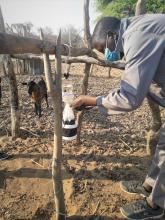Namibia aiming to eliminate malaria through eco-friendly preventive strategies
Approximately 1,629,289 (64%) Namibians are at risk of contracting malaria. Malaria transmission is unstable, seasonal, characterized by outbreaks and concentrated in 7 endemic northern regions. The malaria transmission season typically begins in December and ends in May with the peak transmission months being April and May. The Ministry of Health and Social Services is conducting indoor residual house spraying (IRS) to reduce the malaria mosquito population responsible for transmission as one of several prevention strategies. This will curb the transmission of malaria and eventually eliminate malaria.
However, the use of IRS may have a negative impact on the environment and can cause insecticide resistance which necessitated WHO support to explore alternative interventions such as the use of biological agents which are more friendly to the environment to treat the mosquito breeding sites.
A demonstration larviciding project, is being implemented for more than 3 years in five malarious districts selected from 4 regions namely Omusati, Oshikoto, Ohangwena and Kavango East. The project aims to strengthen National capabilities for the implementation and scaling up of evidence-based, innovative, diversified and environmentally sound malaria vector control interventions as an additional vector control intervention to achieve malaria elimination by 2022. This project also aims to increase the involvement of the community in malaria mosquito control interventions.
To date, 10 study villages and 30 field team members have been identified, this includes twenty-four (24) community members, 10 field operators and five (5) district coordinators i.e. environmental health practitioners (EHPs). After the first training the field team started implementing mosquito larvae habitat mapping and survey until the two refresher trainings have been implemented. This year two refresher trainings of field team members took place, one in March covering the review of larval habitat mapping and larval survey, introduction to adult collection methodologies and morphological identification of adult mosquitoes. A second training was conducted in August introducing the larviciding technique of mosquito breeding sites. After this training the field team members started implementing the adult mosquito collection and larviciding technique in their respective villages. To date three hundred and twenty (320) larval habitats have been mapped as of end of August 2021 out of these only 59 had water and 13 out of the 59 breeding sites had mosquito larvae in them (see the below figure for monthly data). As of September, 5 of the 10 villages are implementing larviciding and so far, all the 9 active mosquito breeding sites have been treated no longer have mosquito larvae in them. The field teams are continuing to monitor breeding sites to ensure that they remain mosquito larvae free. The field teams are also collecting adult mosquitoes from 20 randomly selected households in the respective villages to monitor the mosquito population density and to assess the impact of both the larviciding and IRS.
The project intends to contribute to the reduction of malaria mosquito population in the 5 villages were larviciding is being implemented. It further aims to contribute to the reduction of malaria transmission in the country saving lives of women and children and other vulnerable population in the targeted regions. Findings and lessons from the project will be used for wider application in other countries to ensure that efforts to eliminate malaria considers the environment while saving lives.





